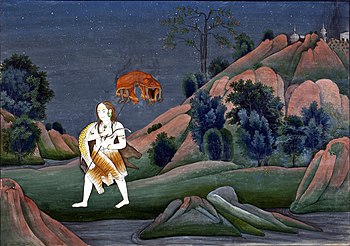Sati (goddess)

In Indian mythology , Satī ( Sanskrit सती Satī ) is the daughter of Daksha . Through a long ascetic life she obtained approval for the wedding with Shiva . Daksha, however, felt disgust for Shiva and did not invite him to his sacrificial fire and feast. The unfortunate satī then killed herself. Shiva's second wife, Parvati , has a lot in common with satī and is therefore considered to be their reincarnation .
myth
In the myth it is said that Satī rejected other men and resolved to win over the ascetic Shiva. Influence on this from Satī's grandfather Brahma is added in some variants of the myth. He wanted to achieve Shiva's sexuality and marriage because Shiva's participation was necessary for the continuation of the world. Satī is usually described as beautiful, but it is primarily her devotion and asceticism that attract Shiva. He grants Sati a wish and she wishes to marry him. In view of her renunciations, he agrees after feeling kama towards her. With the priestly blessing of Brahma, a stately wedding takes place.
Meanwhile, a conflict develops between Shiva and Satī's father Daksha. He rejects Shiva's unconventional behavior and appearance, which have resulted from his long period of renunciation of the world. After the couple have lived in seclusion in the mountains for a long time, Daksha plans a great festival of sacrifice and invites all divine beings, except Shiva and Satī. While Shiva is hardly touched by this, Satī is very angry with her father. She confronts him, but the latter roughly rejects her and insults her husband in public.
So Sati finally kills himself with the help of yoga . In some variants of the myth, she throws herself into the sacrificial fire. Shiva mournfully carries the corpse through the universe and then dismembered it (see Jyotirlinga , see picture). Shiva, now angry, lets Daksha's victim destroy with the power of demons and kill himself. Later, however, the festival of sacrifice takes place again with the revived and repentant Daksha, this time with Shiva.
Origins
The myth of satī is told in slightly different versions in both the Mahabharata epic and the Puranas ; Shiva still appears here under his Vedic name Rudra . Detailed descriptions of the goddess Satī can also be found in the pieces of the Kalidasa from the 5th to 6th centuries.
Parallels to widow burning
There is no exclusive continuity between this myth and the widow burning practice of the same name . Apparently, one thing they have in common is that Sati kills herself and also that she kills herself for her husband. In the case of the myth, she does it because of an insult of Shiva by her father, which can only be cleared up again through a dramatic step such as suicide. So Satī is nonetheless the “faithful woman” in that she subordinates her life entirely to the honor of her husband and sacrifices herself for it. The religious objective of being faithful to one's own husband through self-destruction until death is therefore common to both rite and myth.
One difference arises from the suicide situation. Satī's husband is not dead at the time of her decision, so she is not a widow. Instead of Shiva's death, it is his social status and, above all, her responsibility for him, which drives her to suicide. Only their deed can Shiva's indifference dissolve and lead to a solution to his situation. Accordingly, it is still a benefit in this world that is the reason for the deed, while in the case of a widow burning above all otherworldly (or "post-re-incarnated") reasons become relevant.
However, in view of the principle of the “good wife” a problem arises: Although Satī can solve a single problem of Shiva (his non-acceptance in the established world) through her death, she is no longer able to serve her husband in any other way because of her self-destruction can. Instead, he falls back into asceticism and thus detaches himself from participating in the creative world, which, in the traditional understanding, was actually Satī's task as his wife to prevent. Thus, although she can render him a service in the short term, she can not fulfill the task of satī in the long term . In the Hindu world of gods, this contradiction is resolved by the existence of Parvati . She is a reincarnation of Satī and also a good and faithful woman, whom Shiva can ultimately bind to the world permanently.
literature
- David Kinsley: Indian Goddesses. Female deities in Hinduism. Insel, Frankfurt am Main 1990, ISBN 3-458-16118-X , pp. 59ff.
- Anneliese and Peter Keilhauer: Imagery of Hinduism. The Indian world of gods and their symbolism. DuMont, Cologne 1983, ISBN 3-7701-1347-0 , S, 190f.
- Veronica Ions: Indian Mythology. Hamlyn Publ., London 1983, ISBN 0-600-34285-9 , pp. 44f.